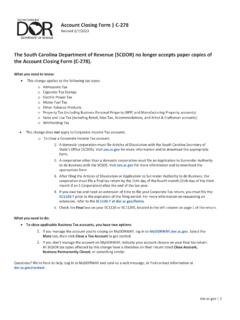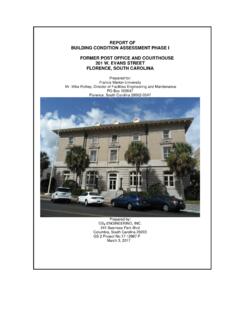Transcription of Charitable Giving and Universities and Colleges
1 Boston University Brandeis University Brown University California Institute of Technology Carnegie Mellon University Case Western Reserve University Columbia University Cornell University Duke University Emory University Georgia Institute of Technology Harvard University Indiana University Iowa State University The Johns Hopkins University Massachusetts Institute of Technology McGill University Michigan State University New York University Northwestern University The Ohio State University The Pennsylvania State University Princeton University Purdue University Rice University Rutgers, The State University of New Jersey Stanford University Stony Brook University - State University of New York Texas A&M University Tulane University The University of Arizona University at Buffalo, The State University of New York University of California, Berkeley University of California, Davis University of California, Irvine University of California, Los Angeles University of California, San Diego University of California.
2 Santa Barbara The University of Chicago University of Colorado at Boulder University of Florida University of Illinois at Urbana-Champaign The University of Iowa The University of Kansas University of Maryland, College Park University of Michigan University of Minnesota, Twin Cities University of Missouri-Columbia The University of North Carolina at Chapel Hill University of Oregon University of Pennsylvania University of Pittsburgh University of Rochester University of Southern California The University of Texas at Austin University of Toronto University of Virginia University of Washington The University of Wisconsin-Madison Vanderbilt University Washington University in St.
3 Louis Yale University Background Americans are a generous people who have a long history of Giving gifts of their time, property , and money to others in need. Whether through individual efforts or the efforts of fraternal, community, religious, or other types of organizations, our nation greatly benefits from the generous Charitable contributions of its citizens. The Charitable gifts of individuals and businesses have been and continue to be used to establish tax-exempt, nonprofit organizations and/or to fund their operations and mission-based activities. The boasts the most robust Charitable sector in the world approximately million tax-exempt organizations in 2012, according to the National Center for Charitable Statistics.
4 This includes approximately one million public charities, or 501(c)(3) organizations, including Universities and Colleges . Individuals and businesses make Charitable gifts of cash, stocks, real estate, patents, art, and other forms of personal property . Non-cash gifts that have a value greater than their original cost are called gifts of appreciated property . Among the most common gifts of appreciated property are common stocks, mutual funds, and real estate. According to the GivingUSA Foundation, Charitable Giving in the United States totaled $316 billion in 2012. Federal Incentives for Charitable Giving Since 1917 with the establishment of the individual income tax deduction for Charitable donations, the federal government has encouraged taxpayers to make donations to Charitable entities.
5 In 1936, the federal government further incentivized Charitable Giving by permitting corporations to deduct Charitable donations from income. The basic principle underlying the Charitable income tax deduction for gifts is that taxpayers should not be taxed on income that does not benefit them directly because they give that income away to support the public good. Under current law, donations to Charitable organizations are tax deductible only for taxpayers who itemize. For itemizers, such donations generally reduce taxable income and, therefore, federal income tax liability. From 1982 to 1986, federal tax law permitted all taxpayers to deduct their Charitable contributions, regardless of whether they used the standard deduction (non-itemizers) or itemized deductions separately.
6 Charitable contribution deductions are generally limited to no more than 50 percent of a taxpayer s adjusted gross income (AGI) and may be limited to 30 or 20 percent of a taxpayer s AGI, depending on the type of property donated and the type of Charitable organization. In general, individual taxpayers who donate to Universities and itemize their deductions can deduct: 1) cash donations and other non-capital gains property in full up to 50 percent of their AGI, and 2) capital gains property in full up to 30 percent of their AGI. However, the 30 percent limit does not apply when the taxpayer chooses to reduce the fair market value of the capital gains property by the amount that would have been long-term capital gain if the taxpayer had sold the property ; instead the 50 percent AGI limit would apply.
7 A taxpayer can generally carry over and use as a Charitable contribution deduction any contribution that the taxpayer is not able to deduct in a tax year because of the foregoing limits in future tax years. An association of 62 leading public and private research Universities Charitable Giving and Universities and Colleges Internal Revenue Code Section 170 Since the enactment of the IRA Charitable Rollover as part of Pension Protection Act of 2006, taxpayers age 70 and older may donate up to $100,000 per year from their Individual Retirement Accounts (IRAs) to public charities, without having to include the distributions as taxable income.
8 The IRA Charitable Rollover is an important recent addition to the federal income tax code that further incentivizes Charitable Giving . Gifts of property and the Charitable Income Tax Deduction Contributions of property , such as real estate, artwork, and collectibles, are subject to strict substantiation and record keeping rules. Taxpayers that claim a Charitable income tax deduction must substantiate the fair market value of the donated property in compliance with IRS rules. Like cash gifts, gifts of appreciated property generally allow taxpayers to receive an income tax deduction and thereby reduce their tax obligations.
9 A taxpayer can claim a Charitable income tax deduction based on the property s fair market value for up to 30 percent of the taxpayer s adjusted gross income and avoid federal capital gains taxes. Such gifts can also reduce certain state and local income taxes and reduce potential estate taxes. A gift of property may involve an outright gift or a partial interest of, intangible property like patents, or tangible property such as art, or real estate. Gifts such as books, art, and collectibles, are tax deductible at their full fair- market value if they have been held by the taxpayer for more than one year and are related to the programs or activities of the Charitable organization.
10 For example, to satisfy the related use standard, a university must be able to use the donated gift in a way that is related to or furthers its educational mission. The amount of the deduction a taxpayer may claim is a function of the fair market value of the property . In general, the fair market value of an item of property is the price that would be agreed on between a willing buyer and a willing seller, neither of whom were under any compulsion to buy or sell and both having reasonable knowledge of relevant facts. With certain exceptions, the IRS requires a written appraisal from a qualified appraiser for donated property valued at more than $5,000.







